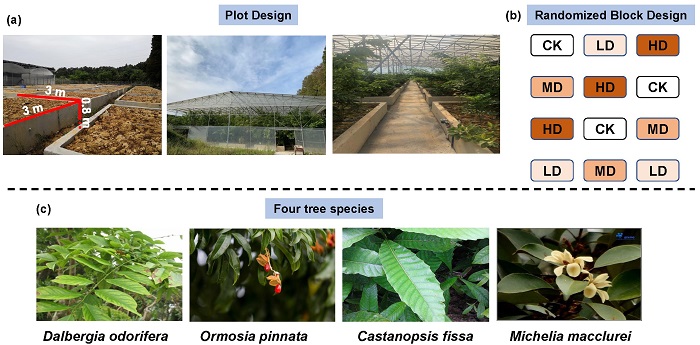

World-wide, forests are experiencing drought-induced mortality. However, physiological adaptation to drought is highly variable, which may lead to differential mortality patterns and alter community structure. In this study, saplings of four common tree species (Ormosia pinnata,Dalbergia odorifera,Castanopsis fissaandMichelia macclurei) grown in subtropical plantations in southern China were subjected to average rainfall and three drought treatments, consisting of low (25% rainfall reduction), moderate (50% rainfall reduction) and high (75% rainfall reduction) drought. To investigate their drought response strategies and select tree species with higher drought tolerance. We found that O. pinnata adapted to drought by decreasing turgor loss point (TLP) and increasing leaf dry matter content and leaf mass per area (LMA). D. odorifera exhibited low leaf minimum conductance and high LMA as the key drought traits to reduce water loss. C. fissa was slowest to initiate stomatal closure but completed stomatal closure more rapidly than the other species. Drought reduced light-saturated photosynthetic rates (Asat) for O. pinnata, D. odorifera and C. fissa primarily due to declining stomatal conductance (gs), with lesser limitations due to the biochemical capacity of Rubisco carboxylation (Vcmax) and electron transport (Jmax). M. macclurei was the first species to close stomata. Drought did not affect Asat for M. macclurei due to stable photosynthetic biochemical processes; however, Vcmax regulation of Asat increased with drought intensity. There was trait variation in the capacity of study trees to tolerate drought, with M. macclurei exhibiting the highest capacity to tolerate drought due to key stomatal (earlier stomatal closure) and hydraulic (lower TLP) traits reducing plant water loss with progressive drought stress.
This result has been published in Environmental and Experimental Botany (IF2021=6.028). Ting Wu and Nadan Tan contributed equally to this work, and professor Juxiu Liu is corresponding author. This paper is the first one in the experimental platform for nitrogen and water completed by Dinghushan Station in 2019. This study was jointly funded by the Key Research and Development Program of Guangdong Province, the National Natural Science Foundation of China and the China Postdoctoral Science Foundation. The site: https://www.sciencedirect.com/science/article/pii/S0098847222002684


